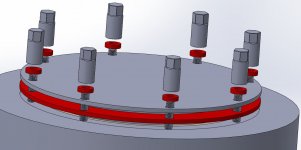i_r_machinist
Titanium
- Joined
- Apr 12, 2007
- Location
- Dublin Texas
I have a very tall castle nut that I'm designing to send out for a quote. It will require a bore that will be threaded 1"-8unc with a depth of at least 3.125" in a blind hole. I thought I would put about 1.5" of thread then relieve behind it. I have found one bar so far that would work for the relief, but it would be extended almost 7d out of the holder. I can change the design so that it is just a deep threaded hole. I'm looking at extended spiral taps now, but don't have much personal experience with such. I can spec the material to a free cutting stainless. If you were going to cut this, what would you rather deal with?

Thanks in advance
i_r_

Thanks in advance
i_r_


